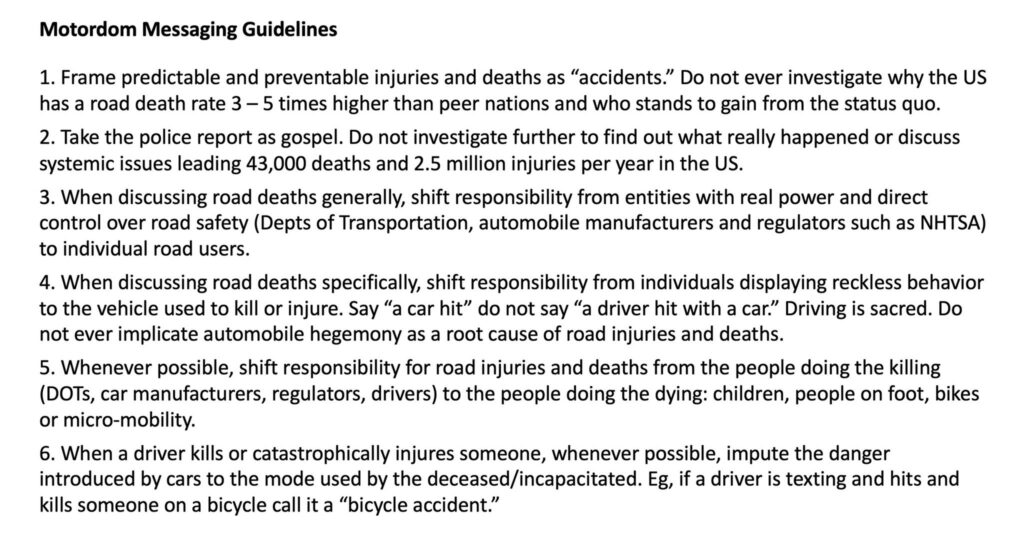Must Read
Some Texas-sized greenwashing for highway widening in Austin. TXDOT is aiming to spend close to $5 billion to widen I-35 through downtown Austin, and to sweeten the deal, they’re producing project renderings showing lengthy caps over portions of the widened freeway. One hitch though: while TXDOT will pay to build the highway, it isn’t going to contribute a dime to building the caps, which are expected to cost a cool billion.
Somebody else will have to come up with the money: but that doesn’t stop TXDOT from shamelessly greenwashing the project with illustrations that show great swaths of green and a barely legible notation that “surface level enhancements to be provided by others.
Rhetorical blame-shifting and denial in face of automobile carnage. Highway deaths, which have been rising for the past several years, are spiking this summer, with a number of particularly painful losses. A driver killed Seventeen year old aspiring professional cyclist with their car; the sports national body described his death as a “training accident.” That produced a visceral reaction from many, including Bella Chu who has some practical advice for spotting the blame-shifting and denial built into standard auto-centric accounts of this ongoing epidemic of traffic violence:
Clip out and save this list and see how many of these misleading messages you can find in press accounts of traffic violence in your city.
The outlook for cities, post-Covid. Rani Molla has an excellent survey article looking at the future of cities in a post-covid, more work-from-home world. Molla touches base with a wide range of experts, getting their views on everything from the decline in office employment due to remote work, to the opportunities for cities to emphasize livability and amenities as economic advantages. Molla writes:
To compete with each other and truly thrive, cities must work on becoming more attractive places to live. Just because big cities are probably going to be fine doesn’t mean they don’t have a lot of challenges or that they couldn’t be a lot better. They do and they can. That means maintaining what already makes cities good and adding things that could make their constituents’ lives better — that’s something that will keep people there and make others come.
As our friend Mary Rowe points out in the article, cities are dynamic and adaptive: they’ve dealt with plenty of changes over the centuries, and the best will change and evolve to succeed in this new environment.
New Knowledge
Migration by income after the pandemic. The Economic Innovation Group has a new analysis, based on county level tax return data showing the difference in incomes of in-migrants and out-migrants.
EIG has a terrific nationwide map that easily lets you drill down to county level data and see changes in income levels, as well as changes in the the number of tax returns filed in each year. The data compares tax year 2021 to tax year 2020. On this map, blue areas saw higher incomes for in-migrants than out-migrants; orange areas had higher incomes for out-migrants than in-migrants.
While the report emphasizes that these are “post-pandemic” changes, there’s a missing baseline here: Specifically, what were the patterns of migration prior to the pandemic and how did they change? Much of what we observe in intra-metropolitan and inter-state moves is a well-established historical pattern: Higher income households (often older people) move from urban center to their suburbs, while central cities tend to attract younger (and lower income households) just starting out. To some extent, this is influenced by marriage: Two single people moving into a city file separate tax returns; a married couple leaving the city files a joint return with a higher income. Similarly, many patterns of interstate migration reflect long established trends (like high income movers leaving New York for Florida, or migrating out of San Francisco). The real question is whether the pandemic accelerated these trends from their historic pattern, and whether this is a temporary blip or a sustained change. As tantalizing as these data are, they don’t answer this question.
Conor O’Brien, “Tax Data Reveals Large Flight of High Earners from Major Cities During the Pandemic,” Economic Innovation Group, August 8, 2023
In the news
The Washington Post cited City Observatory’s study of the persistence and spread of concentrated poverty in their article “Income Ladder is Difficult to Climb in US Metros.”


